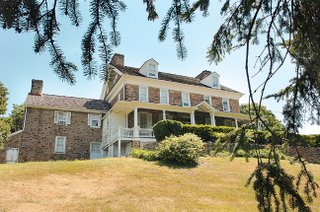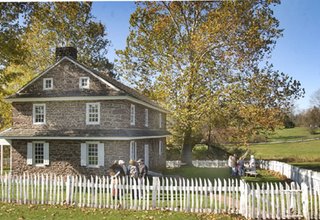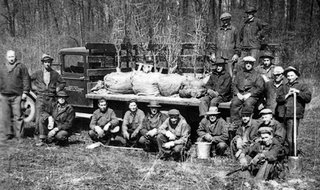Historic sites
Pottsgrove Manor
100 W. King St., Pottstown
610-326-4014
pottsgrovemanor@montcopa.org
POTTSTOWN — Pottsgrove Manor is where John Potts once lived. Raised in Boyertown by his successful iron-master father, Thomas, and stepmother, John gained hands-on experience about the iron industry, which would benefit him the rest of his life.
Thomas, a Quaker who arrived in Philadelphia from Wales in 1698, became a successful businessman largely due to the beneficial connections he made with established families that owned iron forges in the area, such as the Rutter family and the Savage family.
At age 25, John further strengthened that bond when he married Ruth Savage.
Two of the legacies of John are the town of Pottstown and the mansion known as Pottsgrove Manor.
Before John Potts died in 1768, he owned more than 4,000 acres of land in Pennsylvania and Virginia, along with all those businesses. His greatest success was the establishment of Pottstown.
In 1751, John bought nearly 1,000 acres of land from a man named Samuel McCall that eventually became Pottstown and neighboring Pottsgrove.
In 1761, nine years after moving into the mansion, according to a history of Montgomery County, Potts had the surrounding land surveyed with the intention of constructing a town. He had the plans painstakingly laid out in an English grid system similar to Philadelphia and even envisioned his town as matching the biggest city in the colonies.
When Potts died his son Thomas purchased the mansion from the family estate. Thomas was eventually forced to sell the mansion in 1785, Symborski said.
The mansion has survived all those changes, has been restored to its Colonial era look and is a historically significant site.
-- Walter Ault
Pottsgrove Manor is open to visitors Tuesday through Saturday, 10 a.m. to 4 p.m. and Sundays, 1 p.m. to 4 p.m.
 Mill Grove: The John James Audubon House
Mill Grove: The John James Audubon House
1201 Pawlings Road, Audubon
610-666-5593
millgrove@audubon.org
http://pa.audubon.org
The first U.S. home of John James Audubon, a naturalist and artist famous for his guide to birds.
The estate is true to the time when Audubon lived there with fields, bird observation areas, woodlands with trails and a view of the Perkiomen Creek, a pond and an aviary of birds. The house also contains many of Audubon's works.
The site is an educational center for the Audubon Society.
The mansion is open Tuesday-Saturday 10 a.m. to 4 p.m., Sun. 1 to 4 p.m.

Joanna Furnace
Route 345, Morgantown
610-286-0388
info@haycreek.org
http://www.haycreek.org/joanna_furnace.htm
A site of one of the first iron works in Berks County, the historic Joanna Furnace site features a working mill, workers houses and a main house.
Started by Samuel Potts, Thomas Rutter III, Thomas May and Thomas Bull the site was named after Potts' wife, Joanna.
The furnace stopped work in 1898.
Furnace Operation Days are held every third Saturday in the summer with re-enactors, sales and historic tours with other festivals throughout the year.

Daniel Boone Homestead
400 Daniel Boone Road, Birdsboro
610-582-4900
info@danielboonehomestead.org
http://www.danielboonehomestead.org/
"When most people think of Daniel Boone they think of Kentucky, but he was born here in 1734," park guide Ruth Konrad said during a tour of the Boone House which was built in 1730.
In later years, owners William Maugridge and John DeTurk made major changes to the home. The mix of iron, stone and red shale, reflecting English and German influences, is quite a sight.
Boone, as many a textbook have explained, gained immortality on the wild, wild frontier during the country’s infancy, fighting back Indians and leading folks to the virgin Kentucky plains.
In 1773, Boone fell short in his first try to settle Kentucky. He was successful in 1775, and established Boonesborough. As legend goes, Boone returned to the Homestead in 1781 and 1788. He later died in Missouri in the fall of 1820.
Englishman Maugridge purchased the property from the Boone family in 1750. He was a judge from the formation of Berks County in 1752 until his passing in 1766.
A Pennsylvania German, DeTurk obtained the land and resided there until his death in 1808.
Managed by the Pennsylvania Historical and Museum Commission, the 579-acre tract includes seven 18th century structures, a lake, picnic areas and other recreational facilities.
Employing an array of exhibits, programs, tours and publications, the Homestead brings to life the history of the three families that shaped its personality.
"We get about 70,000 to 80,000 visitors a year," said administrator Jim Lewars.
--By Alen Beljin
Hours are March 1 to Dec. 31, Tuesday through Saturday, 9 a.m. to 4:30 p.m., Sundays, noon to 4:30. Closed Mondays. The grounds are open until 5 p.m.
Mouns Jones House
Old Philadelphia Pike, Douglassville
Managed by the Historic Preservation Trust of Berks County
610-385-4762
info@historicpreservationtrust.org
Built in 1716 by Mouns and Ingabor Jones, the house is a two-and-a-half story sandstone building at the south end of what was the original 498-acre tract acquired by Jones in 1701.
Born in 1663, Jones first settled on land acquired from his father in the greater Philadelphia area. He married Ingabor Laicon about 1690 in the Old Swedes Church in Philadelphia.
The couple had five children before moving to Berks County where Mouns Jones was a known friend and confidant to local Native Americans. He died in 1727 and is buried in the churchyard at St. Gabriel's Episcopal, Route 422 East, Douglassville.
The 20- by 36-foot structure is built in the style of an English hall-parlor home with casement-style windows. A deep cellar beneath the home has been filled in over the decades by flooding of the nearby Schuylkill River. A corner fireplace in the parlor reveals lingering Swedish influence.
It is near the historic Morlatton Village on Old Philadelphia Pike along the Schuylkill River.
Morlatton Village
Old Philadelphia Pike, Douglassville
Managed by the Historic Preservation Trust of Berks County
610-385-4762
info@historicpreservationtrust.org
Includes a bridge keepers house, a covered bridge, the George Douglass Mansion, Mouns Jones House and White Horse Inn. Held the only grist mill to serve the Oley Valley region.
 Hopewell Furnace
Hopewell Furnace
Off Route 345, near French Creek State Park and below Birdsboro
Managed by the National Park Service
http://www.nps.gov/hofu/
The restoration of Hopewell Village and Furnace and the creation of the Hopewell Furnace National Historic Site was one of the Civil Conservation Corps' many successes.
Located in eastern Berks County, Hopewell Furnace was constructed in 1771 by iron master Mark Bird. Hard financial times bedeviled Bird during the 1780s, and in 1788 he was forced to sell the furnace at auction.
The furnace was bought in 1800 by members of the Brooke family, a name familiar to Birdsboro area residents. They continued to make iron there well into the 19th century, but eventually couldn't compete with technology of modern steel plants. In the summer of 1883, Hopewell's furnace made its final blast.
When the iron making ended at Hopewell, the Brookes began to turn the area into an agricultural site. During the next 27 years, another 500 acres were purchased, dairy and sheep herds were established, and chicken coops built. Apple orchards were planted and charcoal was sold.
Workers continued to live in the tenant houses, and the Brooke family, now living in Philadelphia and Birdsboro, used the main house occasionally as a summer residence.
In 1935, the federal government purchased 5,500 acres around Hopewell Furnace for use in its CCC program. The acquisition included 4,500 acres owned by the Brooke family, who received $98,301 in payment.
According to Park Superintendent Edie Shean-Hammond, "FDR purchased this land to create French Creek National Recreation Demonstration Area." The CCC workers, she said, were "told to tear all the buildings down."
Fortunately, the men in this CCC Camp were World War I vets, mature men capable of making independent decisions. When they uncovered the furnace ruins and other buildings of historic importance, they objected to the destruction. This sparked an investigation of the site and it was concluded that Hopewell should be restored and its historic significance preserved.
Thus, Shean-Hammond said, Hopewell became "the first historical site in the nation to be saved by the work of the CCC."
In 1938, the National Park Service designated 214 acres within FCNRDA as Hopewell Village National Historic Site.
The site offers hiking trails with trailheads off the main road that are open year round.
-- Michael T. Snyder
Hours: 9 a.m. to 5 p.m. Wednesday through Sunday. Closed Monday, Tuesday and federal holidays. Hiking trails are open daily, year round.
100 W. King St., Pottstown
610-326-4014
pottsgrovemanor@montcopa.org
POTTSTOWN — Pottsgrove Manor is where John Potts once lived. Raised in Boyertown by his successful iron-master father, Thomas, and stepmother, John gained hands-on experience about the iron industry, which would benefit him the rest of his life.
Thomas, a Quaker who arrived in Philadelphia from Wales in 1698, became a successful businessman largely due to the beneficial connections he made with established families that owned iron forges in the area, such as the Rutter family and the Savage family.
At age 25, John further strengthened that bond when he married Ruth Savage.
Two of the legacies of John are the town of Pottstown and the mansion known as Pottsgrove Manor.
Before John Potts died in 1768, he owned more than 4,000 acres of land in Pennsylvania and Virginia, along with all those businesses. His greatest success was the establishment of Pottstown.
In 1751, John bought nearly 1,000 acres of land from a man named Samuel McCall that eventually became Pottstown and neighboring Pottsgrove.
In 1761, nine years after moving into the mansion, according to a history of Montgomery County, Potts had the surrounding land surveyed with the intention of constructing a town. He had the plans painstakingly laid out in an English grid system similar to Philadelphia and even envisioned his town as matching the biggest city in the colonies.
When Potts died his son Thomas purchased the mansion from the family estate. Thomas was eventually forced to sell the mansion in 1785, Symborski said.
The mansion has survived all those changes, has been restored to its Colonial era look and is a historically significant site.
-- Walter Ault
Pottsgrove Manor is open to visitors Tuesday through Saturday, 10 a.m. to 4 p.m. and Sundays, 1 p.m. to 4 p.m.
 Mill Grove: The John James Audubon House
Mill Grove: The John James Audubon House1201 Pawlings Road, Audubon
610-666-5593
millgrove@audubon.org
http://pa.audubon.org
The first U.S. home of John James Audubon, a naturalist and artist famous for his guide to birds.
The estate is true to the time when Audubon lived there with fields, bird observation areas, woodlands with trails and a view of the Perkiomen Creek, a pond and an aviary of birds. The house also contains many of Audubon's works.
The site is an educational center for the Audubon Society.
The mansion is open Tuesday-Saturday 10 a.m. to 4 p.m., Sun. 1 to 4 p.m.

Joanna Furnace
Route 345, Morgantown
610-286-0388
info@haycreek.org
http://www.haycreek.org/joanna_furnace.htm
A site of one of the first iron works in Berks County, the historic Joanna Furnace site features a working mill, workers houses and a main house.
Started by Samuel Potts, Thomas Rutter III, Thomas May and Thomas Bull the site was named after Potts' wife, Joanna.
The furnace stopped work in 1898.
Furnace Operation Days are held every third Saturday in the summer with re-enactors, sales and historic tours with other festivals throughout the year.

Daniel Boone Homestead
400 Daniel Boone Road, Birdsboro
610-582-4900
info@danielboonehomestead.org
http://www.danielboonehomestead.org/
"When most people think of Daniel Boone they think of Kentucky, but he was born here in 1734," park guide Ruth Konrad said during a tour of the Boone House which was built in 1730.
In later years, owners William Maugridge and John DeTurk made major changes to the home. The mix of iron, stone and red shale, reflecting English and German influences, is quite a sight.
Boone, as many a textbook have explained, gained immortality on the wild, wild frontier during the country’s infancy, fighting back Indians and leading folks to the virgin Kentucky plains.
In 1773, Boone fell short in his first try to settle Kentucky. He was successful in 1775, and established Boonesborough. As legend goes, Boone returned to the Homestead in 1781 and 1788. He later died in Missouri in the fall of 1820.
Englishman Maugridge purchased the property from the Boone family in 1750. He was a judge from the formation of Berks County in 1752 until his passing in 1766.
A Pennsylvania German, DeTurk obtained the land and resided there until his death in 1808.
Managed by the Pennsylvania Historical and Museum Commission, the 579-acre tract includes seven 18th century structures, a lake, picnic areas and other recreational facilities.
Employing an array of exhibits, programs, tours and publications, the Homestead brings to life the history of the three families that shaped its personality.
"We get about 70,000 to 80,000 visitors a year," said administrator Jim Lewars.
--By Alen Beljin
Hours are March 1 to Dec. 31, Tuesday through Saturday, 9 a.m. to 4:30 p.m., Sundays, noon to 4:30. Closed Mondays. The grounds are open until 5 p.m.
Mouns Jones House
Old Philadelphia Pike, Douglassville
Managed by the Historic Preservation Trust of Berks County
610-385-4762
info@historicpreservationtrust.org
Built in 1716 by Mouns and Ingabor Jones, the house is a two-and-a-half story sandstone building at the south end of what was the original 498-acre tract acquired by Jones in 1701.
Born in 1663, Jones first settled on land acquired from his father in the greater Philadelphia area. He married Ingabor Laicon about 1690 in the Old Swedes Church in Philadelphia.
The couple had five children before moving to Berks County where Mouns Jones was a known friend and confidant to local Native Americans. He died in 1727 and is buried in the churchyard at St. Gabriel's Episcopal, Route 422 East, Douglassville.
The 20- by 36-foot structure is built in the style of an English hall-parlor home with casement-style windows. A deep cellar beneath the home has been filled in over the decades by flooding of the nearby Schuylkill River. A corner fireplace in the parlor reveals lingering Swedish influence.
It is near the historic Morlatton Village on Old Philadelphia Pike along the Schuylkill River.
Morlatton Village
Old Philadelphia Pike, Douglassville
Managed by the Historic Preservation Trust of Berks County
610-385-4762
info@historicpreservationtrust.org
Includes a bridge keepers house, a covered bridge, the George Douglass Mansion, Mouns Jones House and White Horse Inn. Held the only grist mill to serve the Oley Valley region.
 Hopewell Furnace
Hopewell FurnaceOff Route 345, near French Creek State Park and below Birdsboro
Managed by the National Park Service
http://www.nps.gov/hofu/
The restoration of Hopewell Village and Furnace and the creation of the Hopewell Furnace National Historic Site was one of the Civil Conservation Corps' many successes.
Located in eastern Berks County, Hopewell Furnace was constructed in 1771 by iron master Mark Bird. Hard financial times bedeviled Bird during the 1780s, and in 1788 he was forced to sell the furnace at auction.
The furnace was bought in 1800 by members of the Brooke family, a name familiar to Birdsboro area residents. They continued to make iron there well into the 19th century, but eventually couldn't compete with technology of modern steel plants. In the summer of 1883, Hopewell's furnace made its final blast.
When the iron making ended at Hopewell, the Brookes began to turn the area into an agricultural site. During the next 27 years, another 500 acres were purchased, dairy and sheep herds were established, and chicken coops built. Apple orchards were planted and charcoal was sold.
Workers continued to live in the tenant houses, and the Brooke family, now living in Philadelphia and Birdsboro, used the main house occasionally as a summer residence.
In 1935, the federal government purchased 5,500 acres around Hopewell Furnace for use in its CCC program. The acquisition included 4,500 acres owned by the Brooke family, who received $98,301 in payment.
According to Park Superintendent Edie Shean-Hammond, "FDR purchased this land to create French Creek National Recreation Demonstration Area." The CCC workers, she said, were "told to tear all the buildings down."
Fortunately, the men in this CCC Camp were World War I vets, mature men capable of making independent decisions. When they uncovered the furnace ruins and other buildings of historic importance, they objected to the destruction. This sparked an investigation of the site and it was concluded that Hopewell should be restored and its historic significance preserved.
Thus, Shean-Hammond said, Hopewell became "the first historical site in the nation to be saved by the work of the CCC."
In 1938, the National Park Service designated 214 acres within FCNRDA as Hopewell Village National Historic Site.
The site offers hiking trails with trailheads off the main road that are open year round.
-- Michael T. Snyder
Hours: 9 a.m. to 5 p.m. Wednesday through Sunday. Closed Monday, Tuesday and federal holidays. Hiking trails are open daily, year round.
Labels: historic sites
 RSS
RSS


Links to this post:
Create a Link
<< Home